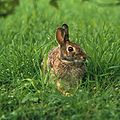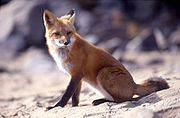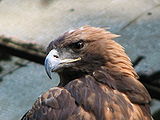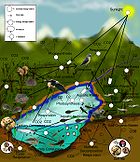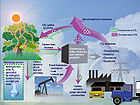- Trophic level
-
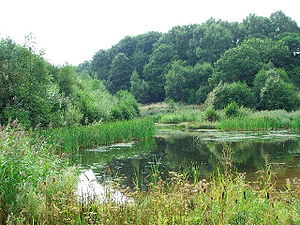

First trophic level
The plants in this image, and the algae and phytoplankton in the lake, are primary producers. They take nutrients from the soil or the water, and manufacture their own food by photosynthesis, using energy from the sun.The trophic level of an organism is the position it occupies in a food chain. The word trophic derives from the Greek τροφή (trophē) referring to food or feeding. A food chain represents a succession of organisms that eat another organism and are, in turn, eaten themselves. The number of steps an organism is from the start of the chain is a measure of its trophic level. Food chains start at trophic level 1 with primary producers such as plants, move to herbivores at level 2, predators at level 3 and typically finish with carnivores or apex predators at level 4 or 5. The path along the chain can form a one-way flow, or a food "web." Ecological communities with higher biodiversity form more complex trophic paths.
Contents
Overview
 Consumer categories based on material eaten (plant: green shades are live, brown shades are dead; animal: red shades are live, purple shades are dead; or particulate: grey shades) and feeding strategy (gatherer: lighter shade of each color; miner: darker shade of each color)
Consumer categories based on material eaten (plant: green shades are live, brown shades are dead; animal: red shades are live, purple shades are dead; or particulate: grey shades) and feeding strategy (gatherer: lighter shade of each color; miner: darker shade of each color)
The three basic ways organisms get food are as producers, consumers and decomposers.
- Producers (autotrophs) are typically plants or algae. Plants and algae do not usually eat other organisms, but pull nutrients from the soil or the ocean and manufacture their own food using photosynthesis. For this reason, they are called primary producers. In this way, it is energy from the sun that usually powers the base of the food chain.[1] An exception occurs in deep-sea hydrothermal ecosystems, where there is no sunlight. Here primary producers manufacture food through a process called chemosynthesis.[2]
- Consumers (heterotrophs) are animals which cannot manufacture their own food and need to consume other organisms. Animal that eat primary producers (like plants) are called herbivores. Animals that eat other animals are called carnivores, and animals that eat both plant and other animals are called omnivores.
- Decomposers (detritivores) break down dead plant and animal material and wastes and release it again as energy and nutrients into the ecosystem for recycling. Decomposers, such as bacteria and fungi (mushrooms), feed on waste and dead matter, converting it into inorganic chemicals that can be recycled as mineral nutrients for plants to use again.
Trophic levels can be represented by numbers, starting at level 1 with plants. Further trophic levels are numbered subsequently according to how far the organism is along the food chain.
- Level 1: Plants and algae make their own food and are called primary producers.
- Level 2: Herbivores eat plants and are called primary consumers.
- Level 3: Carnivores which eat herbivores are called secondary consumers.
- Level 4: Carnivores which eat other carnivores are called tertiary consumers.
- Level 5: Apex predators which have no predators are at the top of the food chain.
-
Second trophic level Rabbits eat plants at the first trophic level, so they are primary consumers. -
Third trophic level
Foxes eat rabbits at the second trophic level, so they are secondary consumers. -
Fourth trophic level
Golden eagles eat foxes at the third trophic level, so they are tertiary consumers. -
Decomposers
The fungi on this tree feed on dead matter, converting it back to nutrients that primary producers can use.
In real world ecosystems, there is more than one food chain for most organisms, since most organisms eat more than one kind of food or are eaten by more than one type of predator. A diagram which sets out the intricate network of intersecting and overlapping food chains for an ecosystem is called its food web.[3] Decomposers are often left off food webs, but if included, they mark the end of a food chain.[3] Thus food chains start with primary producers and end with decay and decomposers. Since decomposers recycle nutrients, leaving them so they can be reused by primary producers, they are sometimes regarded as occupying their own trophic level.[4][5]
Biomass transfer efficiency
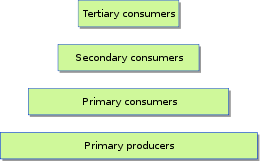 An energy pyramid illustrates how much energy is needed as it flows upwards to support the next trophic level. This diagram is not to scale, because only about 10 % of the energy transferred between each trophic level is converted to biomass.
An energy pyramid illustrates how much energy is needed as it flows upwards to support the next trophic level. This diagram is not to scale, because only about 10 % of the energy transferred between each trophic level is converted to biomass.
Generally, each trophic level relates to the one below it by absorbing some of the energy it consumes, and in this way can be regarded as resting on, or supported by the next lower trophic level. Food chains can be diagrammed to illustrate the amount of energy that moves from one feeding level to the next in a food chain. This is called an energy pyramid. The energy transferred between levels can also be thought of as approximating to a transfer in biomass, so energy pyramids can also be viewed as biomass pyramids, picturing the amount of biomass that results at higher levels from biomass consumed at lower levels.
The efficiency with which energy or biomass is transferred from one trophic level to the next is called the ecological efficiency. Consumers at each level convert on average only about 10 percent of the chemical energy in their food to their own organic tissue. For this reason, food chains rarely extend for more than 5 or 6 levels. At the lowest trophic level (the bottom of the food chain), plants convert about one percent of the sunlight they receive into chemical energy. It follows from this that the total energy originally present in the incident sunlight that is finally embodied in a tertiary consumer is about 0.001 %[4]
Fractional trophic levels
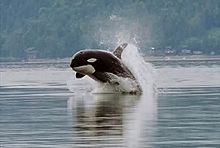 Killer whales (orca) are apex predators. They hunt practically anything, including tuna, smaller sharks and seals.
Killer whales (orca) are apex predators. They hunt practically anything, including tuna, smaller sharks and seals.
Food webs largely define ecosystems, and the trophic levels define the position of organisms within the webs. But these trophic levels are not always simple integers, because organisms often feed at more than one trophic level.[6][7] For example, some carnivores also eat plants, and some plants are carnivores. A large carnivore may eat both smaller carnivores and herbivores; the bobcat eats rabbits, but the mountain lion eats both bobcats and rabbits. Animals can also eat each other; the bullfrog eats crayfish and crayfish eat young bullfrogs. The feeding habits of a juvenile animal, and consequently its trophic level, can change as it grows up.
The fisheries scientist Daniel Pauly sets the values of trophic levels to one in plants and detritus, two in herbivores and detritivores (primary consumers), three in secondary consumers, and so on. The definition of the trophic level, TL, for any consumer species i is:[5]
where TLi is the fractional trophic level of the prey j, and DCij represents the fraction of j in the diet of i.
In the case of marine ecosystems, the trophic level of most fish and other marine consumers takes value between 2.0 and 5.0. The upper value, 5.0, is unusual, even for large fish,[8] though it occurs in apex predators of marine mammals, such as polar bears and killer whales.[9]
Mean trophic level
 The mean trophic level of the world fisheries catch has steadily declined because many high trophic level fish, such as this tuna, have been overfished
The mean trophic level of the world fisheries catch has steadily declined because many high trophic level fish, such as this tuna, have been overfished
In fisheries, the mean trophic level for the fisheries catch across an entire area or ecosystem is calculated for year y as:
where Yiy is the catch of the species or group i in year y, and TLi is the fractional trophic level for species i as defined above.[5]
It was once believed that fish at higher trophic levels usually have a higher economic value; resulting in overfishing at the higher trophic levels. Earlier reports found precipitous declines in mean trophic level of fisheries catch, in a process known as fishing down the food web.[10] However, more recent work finds no relation between economic value and trophic level;[11] and that mean trophic levels in catches, surveys and stock assessments have not in fact declined, suggesting that fishing down the food web is not a global phenomenon.[12]
FiB index
Since biomass transfer efficiencies are only about 10 percent, it follows that the rate of biological production is much greater at lower trophic levels than it is at higher levels. Fisheries catches, at least to begin with, will tend to increase as the trophic level declines. At this point the fisheries will target species lower in the food web.[13] In 2000, this led Pauly and others to construct a "Fisheries in Balance" index, usually called the FiB index.[14] The FiB index is defined, for any year y, by[5]
where Yy is the catch at year y, TLy is the mean trophic level of the catch at year y, Y0 is the catch and TL0 the mean trophic level of the catch at the start of the series being analyzed, and TE is the transfer efficiency of biomass or energy between trophic levels.
The FiB index is stable (zero) over periods of time when changes in trophic levels are matched by appropriate changes in the catch in the opposite direction. The index increases if catches increase for any reason, e.g. higher fish biomass, or geographic expansion [5] Such decreases explain the “backward-bending” plots of trophic level versus catch originally observed by Pauly and others in 1998.[13]
See also
- Cascade effect
- Energy flow (ecology)
- Trophic cascade
- Trophic state index - applied to lakes
References
- ^ Butz SD (2002) Science of Earth Systems Page 537. Cengage Learning. ISBN 9780766833913
- ^ Dover CV (2000) The ecology of deep-sea hydrothermal vents Page 117. Princeton University Press. ISBN 9780691049298
- ^ a b Lisowski M, Miaoulis I, Cyr M, Jones LC, Padilla MJ, Wellnitz TR (2004) Prentice Hall Science Explorer: Environmental Science, Pearson Prentice Hall. ISBN 9780131150904
- ^ a b American Heritage Science Dictionary, 2005. Houghton Mifflin Company.
- ^ a b c d e Pauly, D.; Palomares, M.L. (2005). "Fishing down marine food webs: it is far more pervasive than we thought". Bulletin of Marine Science 76 (2): 197–211. http://www.seaaroundus.org/Journal/2005/FishingDownMarineFoodWebItisfarMorePervasive.pdf.
- ^ Odum WE and Heald EJ (1975) "The detritus-based food web of an estuarine mangrove community". Pages 265–286 in L. E. Cronin, ed. Estuarine research. Vol. 1. Academic Press, New York.
- ^ Pimm, SL; Lanton, JH (1978). "On feeding on more than one trophic level". Nature 275 (5680): 542–544. doi:10.1038/275542a0. http://www.nature.com/nature/journal/v275/n5680/abs/275542a0.html.
- ^ Cortés, E (1999). "Standardized diet compositions and trophic levels of sharks". ICES J. Mar. Sci. 56 (5): 707–717. doi:10.1006/jmsc.1999.0489.
- ^ Pauly, D; Trites, A; Capuli, E; Christensen, V (1998). "Diet composition and trophic levels of marine mammals". ICES J. Mar. Sci. 55 (3): 467–481. doi:10.1006/jmsc.1997.0280.
- ^ Millennium Ecosystem Assessment (2005) Ecosystems and Human Well-being: Synthesis Island Press. Page 32–33.
- ^ Sethi, SA; Branch, TA; Watson, R (2010). "Fishery development patterns are drive by profit, not trophic level". Proceedings of the National Academy of Sciences 107 (27): 12163–12167. doi:10.1073/pnas.1003236107.
- ^ Branch, TA et al.; Watson, Reg; Fulton, Elizabeth A.; Jennings, Simon; McGilliard, Carey R.; Pablico, Grace T.; Ricard, Daniel; Tracey, Sean R. (2010). "Trophic fingerprint of marine fisheries". Nature 468 (7322): 431–435. doi:10.1038/nature09528. PMID 21085178.
- ^ a b Pauly, D; Christensen, V; Dalsgaard, J; Froese, R; Torres, FC Jr (1998). "Fishing down marine food webs". Science 279 (5352): 860–863. doi:10.1126/science.279.5352.860. PMID 9452385.
- ^ Pauly, D; Christensen, V; Walters, C (2000). "Ecopath, Ecosim and Ecospace as tools for evaluating ecosystem impact of fisheries". ICES J. Mar. Sci. 57 (3): 697–706. doi:10.1006/jmsc.2000.0726.
External links
- Trophic levels BBC. Last updated March 2004.
Aquatic ecosystems – general and freshwater components General - Aquatic ecosystems
- Acoustic ecology
- Agent-based models
- Algal bloom
- Anoxic waters
- Aquatic adaptation
- Aquatic animals
- Aquatic biodiversity research
- Aquatic biomonitoring
- Aquatic insects
- Aquatic layers
- Aquatic mammals
- Aquatic plants
- Aquatic predation
- Aquatic respiration
- Aquatic science
- Aquatic toxicology
- Benthos
- Bioluminescence
- Biomass
- Cascade effect
- Colored dissolved organic matter
- Dead zone
- Ecohydrology
- Eutrophication
- Fisheries science
- Food chain
- Food web
- GIS and aquatic science
- Hydrobiology
- Hypoxia
- Isotope analysis
- Microbial ecology
- Microbial food web
- Microbial loop
- Nekton
- Neuston
- Particle
- Photic zone
- Phytoplankton
- Plankton
- Productivity
- Ramsar Convention
- Schooling
- Sediment trap
- Siltation
- Spawning
- Substrate
- Thermal pollution
- Trophic level
- Underwater camouflage and mimicry
- Water column
- Zooplankton
- More...

Freshwater - Freshwater ecosystems
- Brackish marsh
- Freshwater biology
- Freshwater biomes
- Freshwater fish
- Freshwater marsh
- Freshwater swamp forest
- Hyporheic zone
- Lake ecosystems
- Landscape limnology
- Limnology
- Lake stratification
- Macrophyte
- Pond
- Fish pond
- Rheotaxis
- River ecosystems
- Stream bed
- Stream pool
- Trophic state index
- Upland and lowland
- Water garden
- Wetland
- Environmental quality
- More...
Ecoregions - Freshwater ecoregions
- List of freshwater ecoregions
- Marine ecoregions
- List of marine ecoregions
- Ecology of the Everglades
- Ecology of the San Francisco Estuary
- Ecosystem of the North Pacific Subtropical Gyre
- Freshwater ecology of Maharashtra
Aquatic ecosystems – marine components Marine 
Marine
life forms- Census of Marine Life
- Coastal fish
- Coral reef fish
- Deep sea communities
- Deep sea creature
- Deep sea fish
- Deep water corals
- Demersal fish
- Marine bacteriophage
- Marine invertebrates
- Marine larval ecology
- Marine mammal
- Marine reptile
- Marine vertebrate
- Paradox of the plankton
- Pelagic fish
- Seabird
- Seashore wildlife
- Wild fisheries
Marine
habitats- Bay mud
- Black smokers
- Coastal biogeomorphology
- Cold seeps
- Coral reefs
- Davidson Seamount
- Estuaries
- Intertidal ecology
- Intertidal wetland
- Kelp forests
- Hydrothermal vent
- Lagoons
- Mangroves
- Marine biomes
- Marine habitats
- Mudflat
- Rocky shores
- Salt marshes
- Seagrass meadows
- Sponge reefs
- Tide pools
Issues - Ecological values of mangrove
- Fisheries and climate change
- HERMIONE
- Marine conservation
- Marine conservation activism
- Marine pollution
- Marine Protected Area
Categories:- Fisheries
- Ecology
Wikimedia Foundation. 2010.

